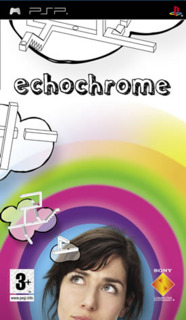Echochrome brings us into a miraculous space where the principles of physics are replaced by the rules of imagination
Echochrome is also the name given to the world in this game. If our real world operates under certain physical principles, Echochrome is governed by another important factor: perspective (or view angle). Five basic rules arise from this essential factors, including Connect, Existent, Absent, Landing and Jump. They not only decide the game play but sometimes result in very strange phenomena which seem to contradict all physical and geometric knowledge we ever have. Now I'm sure many readers still feel confused about how we play this game. In fact, the gameplay is extremely simple but to describe it without illustrative images must be quite challenging even for native English speakers, let alone learners like me. Anyway, let's start with a simple example.
We begin with an effigy, and the task is as simple as moving it along the parallelepipeds which are randomly arranged for each scene. Of course, "Randomly" means the locations of these blocks do not follow any rule: some are attached to another, some far away, some lie on different surfaces and so forth. One way or another, your effigy has to move continuously across these blocks. This is where the five rules above come to the scene. Take Connect rule as an example, in the situation when you reach the end of a surface and it's separated from other surfaces by gaps, you can try rotating the camera to an angle from which your current position "looks like" linking to another block. And then the effigy can confidently pass the gap without being afraid of falling down. Now let's move on to Existent rule. When the way is blocked by an obstacle, simply change the view angle so that the obstacle could no longer be seen, then walk through as if it never existed! Similarly, Landing principle allows you to drop your effigy from one point to another in the same surface! Everything needed to be done is rotating the camera. As already seen, these five rules can be creatively applied to solve many impossible situations. Notice that in any case, the point of view always plays a critical role.
After mastering the rules of this strange world, your objective is to collect "echoes" scattered around the map. Collecting is nothing different from moving to the location and touch these echoes (similar to "eat" food in platformers). Besides, there is an option to increase difficulty level of the game. In this mode, called Pair, there are black effigies moving in the blocks and you have to control your white effigy to dodge them, otherwise they both will return the starting location. It's extremely hard because game only allows controlling the white effigy, others automatically move all the time. In difficult scenes, the number of effigies is large and the whole map looks turbulent as if it were in a maze with countless minotaurs running around.
Proportional to game play, graphics in Echochrome can also be considered incomparable. It seems too simplistic compared to other games on PSP, with only two colors: black and white. Figures in game are mere 3D blocks of different types. Nevertheless, it would be a fatal mistake to make light of graphical quality of the game. The point is developers have put all their effort in creating a friendly presentation which can be easily perceived by everybody. Players can concentrate totally on solving the problems other than being distracted by complex shapes and colors. Apart from that, you will be surprised by the background sound tracks. They are not exciting rock songs or turbulent hip-hop. Instead, we have melodious violin solo pieces in classical manner. Let's try to imagine a black-and-while space filled with masterful recitals, you will understand the consistent idea behind the game. It is meant to be an escape from not only the real world, but also the worlds of gun-fires and bloodshed which are built by almost every video game nowadays.

